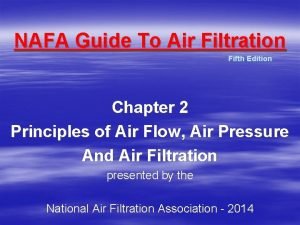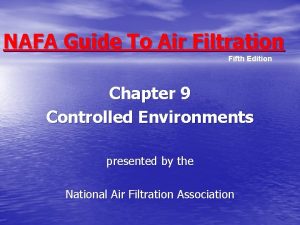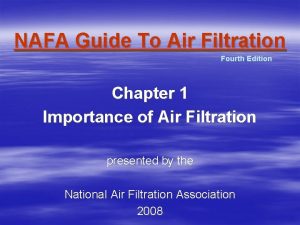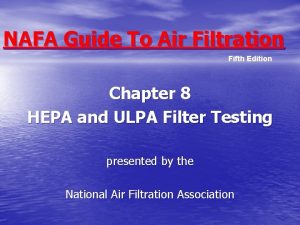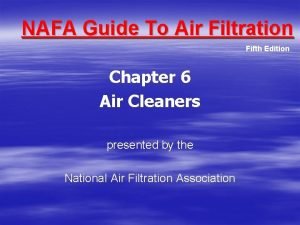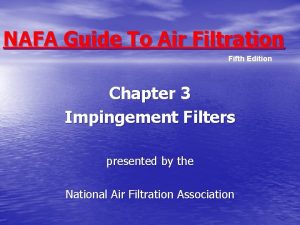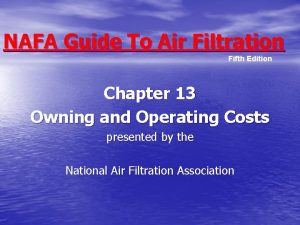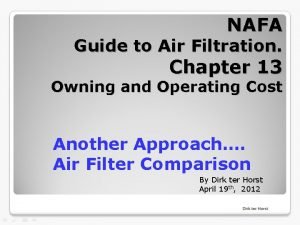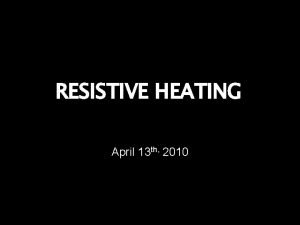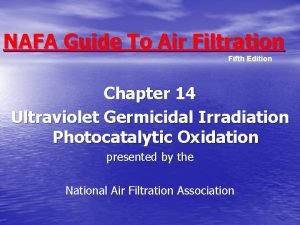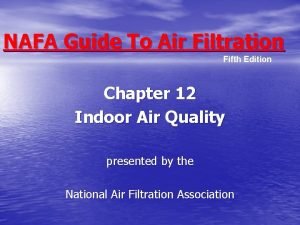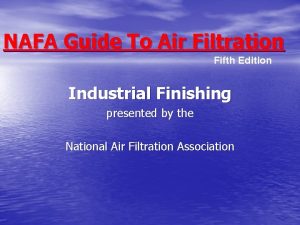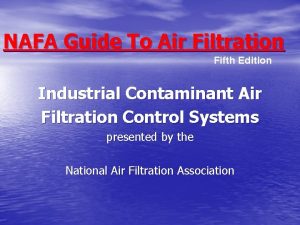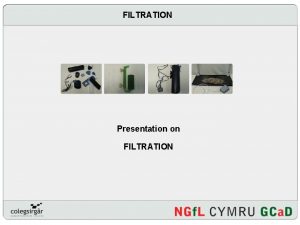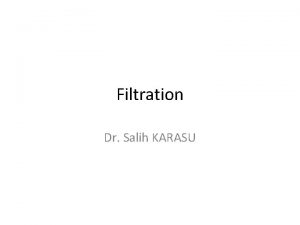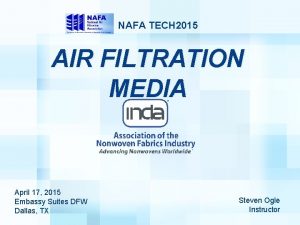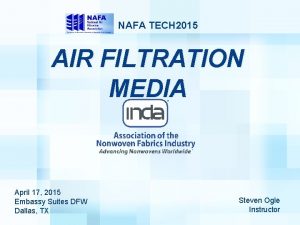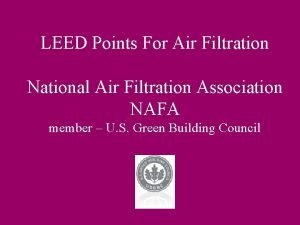NAFA Guide To Air Filtration Fifth Edition Chapter


















- Slides: 18

NAFA Guide To Air Filtration Fifth Edition Chapter 4 Extended Surface Filters presented by the National Air Filtration Association

Extended Surface Filters • The most common method of increasing media area is to pleat the filter media to extend the filter depth. • Extended surface filters have a media area that is greater than the filter face area. • Media velocity is less than face velocity.

Remember - Formula for Figuring Media Velocity? Q = VA V = Q/A A = Q/V Where: (fpm) Q = cubic feet per minute (cfm) V = velocity in feet per minute A = Area in square feet

Extended Surface Filters Are Desirable Because: • Use Interception and Diffusion Principles • Media performs more efficiently at lower media velocities. • Media resistance too high if used as a flat sheet. • Media resistance is, as a general rule, directly proportional to the velocity of air through it. • Extended filter service life

Types of Extended Surface Filters Extended surface filters are characterized by the type of media used and the configuration into which it is formed. Pleat Pocket Cell

Types of Media • Cotton/Polyester or polyester - flat media used • • in pleated panel filters Lofted Polyester Media – same polyester material found in rolls, rings & links, configured into extended surface filter Synthetic Fiber Mats – spunbond and meltblown manufactured fibers Lofted Microglass Media – composed of fine microglass fibers Wet Laid Microglass – made similar to cellulose paper

Lofted Microglass Mat Type Media – Pocket or Rigid Box Filters • Glass mat is composed of very fine glass microfibers – see page 4. 2 for fiber thickness • Requires a backing material to provide physical support. • The efficiencies of mats of different thicknesses are essentially the same. • Mats available in ¼ and ½ inch thickness.

Calculating Pocket Filter Media Area 24” x 22” 6 Pocket Each Pocket 24 H * 22 D * 2 = 1056 sq in /144 = 7. 33 sq ft Whole Filter 7. 3 sq ft * 6 = 43. 98 sq ft Media Velocity 2000 cfm / 43. 98 sf = 45. 4 fpm 24” x 12” 10 Pocket Each Pocket 24 H * 12 D * 2 = 576 sq in /144 = 4 sq ft Whole Filter 4 sq ft * 10 = 40 sq ft Media Velocity 2000 cfm / 40 sf = 50 fpm

Standard Filter Mat Colors and Efficiencies (Lofted Microglass Media) • Yellow MERV 14 • Pink MERV 13 • Orange MERV 11 • Tan 50 -MERV 9 Synthetics have no standard color coding

Synthetic Fiber Mat Type Media • Available in efficiencies comparable to glass media. • Made from various synthetic materials. • Have greater physical strength than glass mats. • May be heat sealed or Sonic welded.

Style and Media • Pleated filter-cotton/polyester blended or all synthetic-rarely microglass • Pocket filters - lofted microglass or synthetic

Style and Media • Rigid box type-lofted microglass or synthetic • Cell-type-wet laid microglass • Minipleat V-cell -wet laid microglass

Residential Deep Pleated Filters Deep pleated microglass and synthetic media is also available for use in residential applications

Filter Installations • The higher the efficiency the better the seal must be to prevent by-pass. • Holding frames must be properly gasketed. • Clamps must provide a tight seal between the filter face and the gasket. • Filter banks must be suitable reinforced to provide rigidity.

Side Access Housings Note gasketing on door

Filter Performance • Best determined from independent filter testing laboratory • ANSI/ASHRAE Standard 52. 2 -2012 (MERV)

Sample Questions Lofted Glass Media can be found most often in what style(s) of filters? Pocket Filters or Rigid Filters Minipleats have more media than most extended surface filters providing two advantages – what are they? Lower initial pressure drop & longer life in service Filter efficiency is best determined by a(n)…? Independent laboratory ANSI/ASHRAE 52. 2 test

Thank you. Other Questions?
 Nafa guide
Nafa guide Nafa guide to air filtration
Nafa guide to air filtration Nafa guide to air filtration
Nafa guide to air filtration Penatrometer
Penatrometer Nafa guide to air filtration
Nafa guide to air filtration Impingement in filtration
Impingement in filtration Nafa guide to air filtration
Nafa guide to air filtration Nafa guide to air filtration
Nafa guide to air filtration Filter medium resistance formula
Filter medium resistance formula Principles of marketing fifth european edition
Principles of marketing fifth european edition Facial feedback hypothesis
Facial feedback hypothesis Fundamentals of corporate finance fifth edition
Fundamentals of corporate finance fifth edition Fifth edition chemistry a molecular approach
Fifth edition chemistry a molecular approach Molecular biology of the cell
Molecular biology of the cell Molecular biology of the cell fifth edition
Molecular biology of the cell fifth edition Human anatomy fifth edition
Human anatomy fifth edition Human anatomy fifth edition
Human anatomy fifth edition Hubungan air tanah dan tanaman
Hubungan air tanah dan tanaman Nafa 120v3
Nafa 120v3
